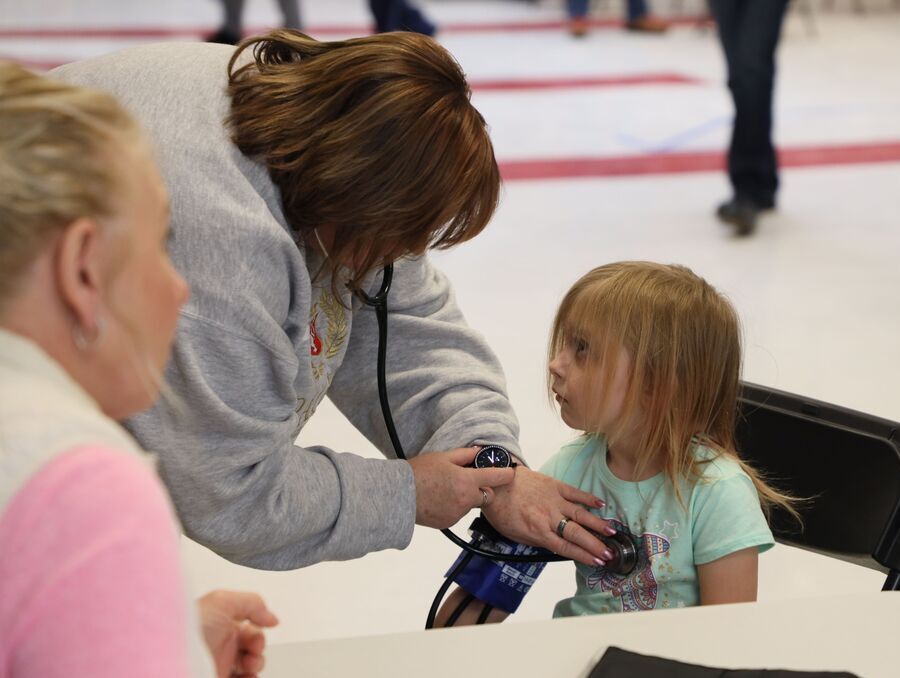“Fragile and at-risk” is how Nevada’s public health infrastructure could be described based on the findings of a recent assessment conducted by University of Nevada, Reno Extension, in partnership with the Nevada Association of Counties. The assessment, which maps the public health infrastructure in 15 of 17 counties in Nevada (excluding the two most urban counties, Clark and Washoe), provides baseline data for decision-makers and stakeholders as they consider the needs of their communities.
Over the past year, Extension’s Nevada Economic Assessment Project team worked with the Nevada Association of Counties to conduct an assessment of the state’s public health infrastructure to provide local governments, policymakers and local organizations with data to help them prioritize the highest needs in their communities and propose solutions.
“This is a base data collection that allows us to see what’s really going on in Nevada, see what we have, see what we’re missing, and then from there, perhaps we can improve,” Joe Lednicky, Extension economist who headed up the 125-page assessment posted online, Foundational Public Health Services in Suburban, Rural and Frontier Nevada, said.
Public health infrastructure focuses on the health of a population, not individual health care. While the term infrastructure may elicit thoughts of buildings, public health infrastructure also includes people and programs available in the community, as well as capacity and expertise. Food inspection, water and air quality monitoring, mosquito abatement, and emergency response are all also examples of public health efforts that individuals may not think about when considering the subject.
“When public health is done well, you often don’t know it’s being done,” Amy Hyne-Sutherland, Nevada Association of Counties public health coordinator, said. “The gaps shown in this comprehensive assessment are real opportunities to serve our communities. Solid public health infrastructure can have lasting positive impacts on Nevadans that reach beyond the measure of public health. It sets the pathway for solid economic development and a pathway to meet the needs of all of our residents.”
Hyne-Sutherland noted that while many studies are done on community health needs, an assessment on Nevada’s public health infrastructure had not been done outside Clark and Washoe counties.
“Community health needs assessments are done frequently,” Hyne-Sutherland said. “But this was not a health needs assessment; it was about infrastructure – what is in place to meet the needs of constituents.”
Large counties, limited resources: Assessing Nevada’s fragile public health system
For this assessment, the focus was on 13 key components consisting of foundational areas and foundational capabilities, which are all part of a national tool called the Foundational Public Health Services Assessment. The foundational areas included communicable disease control; chronic disease and injury prevention; environmental public health; maternal, child and family health; access to and linkage with clinical care. The foundational capabilities included assessment and surveillance; community partnership development; equity; organizational competencies; policy development and support; accountability and performance management; emergency preparedness and response; and communications. This national tool used was adapted to accommodate Nevada’s unique landscape, with its large counties consisting of rural communities geographically spread out throughout much of the state.
“Nevada’s geography, Nevada’s infrastructure for public health is so unique,” Hyne-Sutherland said. “I don’t think that most Nevadans realize how different our state is than other states in terms of size of counties. We have 17 counties. The average number of counties in states in the U.S. is 63. And in most U.S. states, there is a health department, a local health department, in every single county no matter how small. We don’t have a full-time local department in each of our 17 counties, even though many of them are giant counties.”
The assessment included online surveys followed by in-person meetings with stakeholders in each county consisting of county leadership, emergency managers, CEOs from critical access hospitals, school district administrators and others. It focused on rating the health authority on these criteria. Hyne-Sutherland said a lot of counties rely on their human services teams, local nonprofits and similar organizations that help with some of these public health infrastructure services
“Local coordination around health-related services is often very good, but we were focusing specifically on public health services delivered by the actual public health authority,” Hyne-Sutherland said. “For many counties, that is the Department of Public and Behavioral Health, but it also includes the Central Nevada Health District, which serves four counties (Mineral, Pershing, Eureka and Churchill) and the City of Fallon. These authorities have expert, passionate staff who are working with very limited resources. When the health authority has such a massive area to serve, and there is a lack of funding, it can be very difficult. The more local you get, the easier it becomes to coordinate and efficiently build infrastructure. The Central Nevada Health District, for example, is a new district. It required local investment to stand up, but it’s worth it, as they are already making strides in improving local delivery of service.”
The Nevada Association of Counties and other key stakeholders have been educating lawmakers and policy leaders on the need for sustainable funding of Nevada’s public health infrastructure. This assessment enables communities to focus those dollars where it is needed most and use them wisely in partnership with the local health authority and the residents the counties serve.
“I don’t mean to be alarmist,” Hyne-Sutherland said. “A lot of strides were made with COVID-relief funding, ARPA dollars, even SB 118, but that was one-time funding. We’re in this perpetual state of being at risk and fragile with our public health system because we are largely grant funded. We don’t have noncategorical, sustainable funding. And so, the result is that we get what we pay for, which is hardly anything. Nevada ranks 47th in the nation for state investment in public health.”
Public health care gaps: Geographic inequity undermines Nevada’s health infrastructure
Accountability and performance management fared the worst across the state. Geographic equity was also rated low. According to the assessment, “For most of the counties surveyed, direct services (either delivered by the health authority or by a community agency that has been contracted to provide services) are frequently limited to a single population center within a county.”
“The results of the assessment showed that geographical location really impacted service level.” Hyne-Sutherland said. “We think it’s important for policymakers to see this data, and we will work to address this across our county membership.”
The geographic inequity was linked to low scores for chronic disease and injury prevention, and access to clinical care.

“Those kinds of things go hand in hand with a lack of health care across rural and frontier parts of the state,” Hyne-Sutherland said. “Because if you’re in Goldfield, it’s a two-hour-plus drive to the closest hospital, should something happen. While that is partially health care and partially public health, that distance also affects things like kids needing physicals for school sports or immunizations to start the school year or things of that nature. Where some of those heath care offerings aren’t necessarily available, it impacts chronic disease and injury prevention.”
While many results rated the infrastructure at the low end, as a whole, counties across the state had high ratings for emergency preparedness and response. The assessment reflects that this capability area was bolstered by regular Local Emergency Planning Committee meetings, support and regular communication from multiple state agencies, and a dedicated Public Health Preparedness Program supported at the state and local level.
Interstate collaboration: Unlocking public health potential across Nevada
Additionally, there were areas that offered room for optimism. The biggest opportunity was related to communication, which was identified as a key strength. This is because of the ability for improvements to be made simply by increasing collaboration.
“There are state programs and health district programs that maybe do have some grant funding, but they’re not implemented everywhere because there isn’t a local team,” Hyne-Sutherland said. “There isn’t always capacity to do that, but there might be availability if there was more communication.”
She also said that through the process of the assessment, participants also learned about resources they could access, but just didn’t know about.
“People in the meeting would say ‘Oh, I work in the school district, and this isn’t happening here yet,’” Hyne-Sutherland said. “Or they’d respond with, ‘Oh, I’m not even aware of that program.’”
Extension Specialist Marlene Rebori, who helped plan and facilitate the in-person meetings following the survey, also noted that individuals in the communities themselves were an asset, especially as they participated in the process, as they helped to paint an honest picture of the needs in their community.
“They love their communities and they’re very proud of their communities,” Rebori said.
She further noted how important the community engagement component of the project was.
“You bring the people in who are affected, and who are impacted by the decision and have them provide their input about what’s really happening, what’s going on,” Rebori said.
With the assessment completed, Hyne-Sutherland says it can be used in a variety of ways and that it is delivered in a way that makes it easy to use.
“There are 13 areas that we looked at, the 13 foundational public health services,” Hyne-Sutherland said. “For each of those areas, it has opportunities that are very tangible and very specific. Without having done the study, these findings would not have come to light. In addition to counties, I hope that health authorities, not-for-profits and other community agencies use it. The application is broad. It can be used as an advocacy tool. It can be used for strategic planning. Counties can use this as a guide to make targeted, strategic investment in their region or in their county.”
The Foundational Public Health Services in Suburban, Rural and Frontier Nevada assessment was funded through a Centers for Disease Control grant subawarded from the Nevada State Division of Public and Behavioral Health. For questions about the assessment, contact Lednicky or call him at 702-948-5971.

